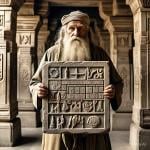THE QUESTIONS:
What was “The Bible Code”? Was it valid? Did it prove anything about God, or the Scriptures, or world events?
THE RELIGION GUY’S ANSWER:
Time for a nostalgic look back at “The Bible Code” sensation upon the death last month of journalist Michael Drosnin, who scored big with his 1997 best-seller of that title and two sequels that inspired imitators, though Hollywood’s film version never got off the ground.
Drosnin’s titillating claim was that the Hebrew Bible’s text contained secretly coded, uncanny predictions of phenomena across the subsequent thousands of years that could only be revealed through modern computers. The fad has not totally died out. Inevitably, we even got the 2015 pamphlet “Donald Trump in the Bible Code: New Testament Echoes of America’s Future Leader.”
Some thought Drosnin’s book meant the biblical God not only inspired the Bible but cleverly knitted in hidden messages for contemporary humanity. Yet, as The New York Times obituary noted, Drosnin himself was a devoted atheist from his days at Hebrew school in New York City.
All quite diverting. But as we’ll see, experts both scientific and religious deemed the whole business to be bogus.
The story in brief: The traditional Jewish practice of “gematria” assigns a number to each letter of the Hebrew alphabet to calculate the numerical value of a word. A variation originated with Orthodox Rabbi Michael Weissmandel, who moved from Eastern Europe to the U.S. following the Nazi Holocaust and died in 1957. He looked for patterns through Equidistant Letter Sequences (ELS) counted by hand, for instance seeing what a word produced by every 50th letter in a text might show.
Intrigued by this, Eliyahu Rips of Israel’s Hebrew University worked with two fellow mathematicians to manipulate the Hebrew text of the book of Genesis into lines of various lengths. They reported discovering the names of 32 leading rabbis across Jewish history located on the grid near their dates of birth, death, or both.
After a major scientific journal rejected the trio’s article about this, it was accepted in 1994 by the respected, peer-reviewed Statistical Science as “a challenging puzzle” for discussion. Drosnin picked up the idea to seek supposed hidden predictions of modern events and sold the book on his findings to an establishment publisher, Simon and Schuster. The rest is history – or hysteria.
In “dramatic confirmation,” Drosnin wrote, one word conjunction meant Israel’s Prime Minister Yitzhak Rabin would be assassinated. Drosnin said he even tried unsuccessfuly to get a warning to Rabin two months before this actually happened. Unfortunately for the cause, Drosnin later announced that the Code prophesied an atomic world war would begin in Israel in 2000 or 2006 and that Prime Minister Benjamin Netanyahu would also be assassinated.
Wry computer scientist Brendan McKay of Australian National University was among those saying forget the Bible. This trick works with any old text. He processed Melville’s novel “Moby-Dick” and located references to the murders of Lincoln, Trotsky, Indira Gandhi, Martin Luther King, John F. Kennedy, and Princess Diana. Then those 32 famous rabbis popped up in Tolstoy’s “War and Peace.” Another wag manipulated Lincoln’s Gettysburg Address and found “Civil War,” “Battlefield,” “Lee, “Meade,” “Grant,” and, oh yes, “Booth.” Some had similar fun with the text of “The Bible Code” itself.
The key mathematical question is whether Code results are simply what you’d expect by pure chance. That was the all-important contention from McKay and three other specialists who debunked the Code in a 1999 follow-up for Statistical Science. See www.math.toronto.edu/drorbn/Codes/StatSci.pdf
The Religion Guy readily confesses total incompetence in following this probability argument. He only survived high school trigonometry through the mnemonic miracle of Soak-A-Toe-uh (SohCahToa). Huh? You can look it up at www.mathsisfun.com/algebra/sohcahtoa.html
However, the clincher is literary, not mathematical, and comes in section 11 of the 1999 article. Christian defense organizations objected to the Bible Code as superstitious, and unfitting because the Bible provides clear messages without such games. But they often ignored the factor that, The Guy proposes, demolishes all Codesmanship.
Code fans used Hebrew letters without punctuation or spaces between words, and no vowels because they did not exist in early Hebrew, following the 1962 Koren Publishers Bible. Textual experts know there’s no possibility that this well-regarded edition preserves the letter-for-letter, word-for-word Hebrew that was originally written down thousands of years ago. If even one letter shifts, the ELS sequence is destroyed and the alleged coded words are scrambled.
Now, it’s true that Jewish scribes’ preservation and transmission of the Hebrew Bible across the ages was incredibly accurate. This was proven by comparing the text of Isaiah, rediscovered a generation ago with the Dead Sea Scrolls, with the later Jewish texts from medieval times that underlie modern Bibles. However, the Scrolls also show there were different manuscript traditions with some biblical books.
Not only that. There’ve always been variations in spelling and uncertainty about what vowels were originally intended with some words. That’s why modern Bibles have footnotes that offer alternative readings on certain verses or admit that a particular translation is the best educated guess. None of this distorts the substance of Scripture, but specialists say we simply do not have one single, agreed-upon, verbatim, letter-for-letter text of the original Hebrew Scriptures. To repeat. There can be no one authentic ELS sequence.
A sequel: Six years after Drosnin’s big book, the same popular lust for ancient secrets exploded again with the huge-selling “The Da Vinci Code” by Dan Brown (now back in the news over a scandalous financial and sexual lawsuit). Although this was a novel, it purported to tell the history of biblical texts and produced chuckles or migraines among scholars. The Guy can’t get into all that in this item, but here’s a typical list of grievances from the Christian Apologetics and Research Ministry. https://carm.org/da-vinci-code












